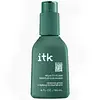What's inside
What's inside
 Key Ingredients
Key Ingredients

 Benefits
Benefits

 Concerns
Concerns

 Ingredients Side-by-side
Ingredients Side-by-side

Water
Skin ConditioningSodium Cocoyl Isethionate
CleansingCocamidopropyl Hydroxysultaine
CleansingCocamidopropyl Betaine
CleansingGlycerin
HumectantSodium Benzoate
MaskingPropanediol
SolventPEG-120 Methyl Glucose Dioleate
EmulsifyingCaprylyl/Capryl Glucoside
CleansingSodium Chloride
MaskingGlycol Distearate
EmollientLaureth-4
EmulsifyingGuar Hydroxypropyltrimonium Chloride
Skin ConditioningPanthenol
Skin ConditioningDisodium EDTA
Sodium Hyaluronate
HumectantBromelain
Skin ConditioningWater, Sodium Cocoyl Isethionate, Cocamidopropyl Hydroxysultaine, Cocamidopropyl Betaine, Glycerin, Sodium Benzoate, Propanediol, PEG-120 Methyl Glucose Dioleate, Caprylyl/Capryl Glucoside, Sodium Chloride, Glycol Distearate, Laureth-4, Guar Hydroxypropyltrimonium Chloride, Panthenol, Disodium EDTA, Sodium Hyaluronate, Bromelain
Water
Skin ConditioningGlycerin
HumectantPropanediol
SolventDicaprylyl Carbonate
EmollientHydroxyethyl Acrylate/Sodium Acryloyldimethyl Taurate Copolymer
Emulsion StabilisingSqualane
EmollientCocamidopropyl Hydroxysultaine
CleansingButyrospermum Parkii Butter
Skin ConditioningSorbitan Oleate Decylglucoside Crosspolymer
CleansingBetaine
HumectantAvena Sativa Kernel Extract
AbrasiveSaccharide Isomerate
HumectantEthylhexylglycerin
Skin ConditioningSodium Acrylate/Sodium Acryloyldimethyl Taurate Copolymer
Emulsion StabilisingPolyisobutene
Caprylyl/Capryl Glucoside
CleansingSodium Surfactin
CleansingSorbitan Isostearate
EmulsifyingSorbitan Oleate
EmulsifyingTetrasodium Glutamate Diacetate
Citric Acid
BufferingChlorphenesin
AntimicrobialSodium Benzoate
MaskingWater, Glycerin, Propanediol, Dicaprylyl Carbonate, Hydroxyethyl Acrylate/Sodium Acryloyldimethyl Taurate Copolymer, Squalane, Cocamidopropyl Hydroxysultaine, Butyrospermum Parkii Butter, Sorbitan Oleate Decylglucoside Crosspolymer, Betaine, Avena Sativa Kernel Extract, Saccharide Isomerate, Ethylhexylglycerin, Sodium Acrylate/Sodium Acryloyldimethyl Taurate Copolymer, Polyisobutene, Caprylyl/Capryl Glucoside, Sodium Surfactin, Sorbitan Isostearate, Sorbitan Oleate, Tetrasodium Glutamate Diacetate, Citric Acid, Chlorphenesin, Sodium Benzoate
 Reviews
Reviews

Ingredients Explained
These ingredients are found in both products.
Ingredients higher up in an ingredient list are typically present in a larger amount.
Caprylyl/Capryl Glucoside is an alkyl glucoside. This just means it is creating by reacting alcohol and sugar. It is a cleansing and foaming ingredient.
Caprylyl/Capryl Glucoside helps remove the dirt, oil, and other pollutants from your skin.
Cocamidopropyl Hydroxysultaine is a synthetic cleansing agent, though it is derived from coconut oil.
It is used to enhance the texture of products by boosting lather and thickening the texture. As a cleanser, Cocamidopropyl Hydroxysultaine is mild.
Glycerin is already naturally found in your skin. It helps moisturize and protect your skin.
A study from 2016 found glycerin to be more effective as a humectant than AHAs and hyaluronic acid.
As a humectant, it helps the skin stay hydrated by pulling moisture to your skin. The low molecular weight of glycerin allows it to pull moisture into the deeper layers of your skin.
Hydrated skin improves your skin barrier; Your skin barrier helps protect against irritants and bacteria.
Glycerin has also been found to have antimicrobial and antiviral properties. Due to these properties, glycerin is often used in wound and burn treatments.
In cosmetics, glycerin is usually derived from plants such as soybean or palm. However, it can also be sourced from animals, such as tallow or animal fat.
This ingredient is organic, colorless, odorless, and non-toxic.
Glycerin is the name for this ingredient in American English. British English uses Glycerol/Glycerine.
Learn more about GlycerinPropanediol is an all-star ingredient. It softens, hydrates, and smooths the skin.
It’s often used to:
Propanediol is not likely to cause sensitivity and considered safe to use. It is derived from corn or petroleum with a clear color and no scent.
Learn more about PropanediolSodium Benzoate is a preservative. It's used in both cosmetic and food products to inhibit the growth of mold and bacteria. It is typically produced synthetically.
Both the US FDA and EU Health Committee have approved the use of sodium benzoate. In the US, levels of 0.1% (of the total product) are allowed.
Sodium benzoate works as a preservative by inhibiting the growth of bacteria inside of cells. It prevents the cell from fermenting a type of sugar using an enzyme called phosphofructokinase.
It is the salt of benzoic acid. Foods containing sodium benzoate include soda, salad dressings, condiments, fruit juices, wines, and snack foods.
Studies for using ascorbic acid and sodium benzoate in cosmetics are lacking, especially in skincare routines with multiple steps.
We always recommend speaking with a professional, such as a dermatologist, if you have any concerns.
Learn more about Sodium BenzoateWater. It's the most common cosmetic ingredient of all. You'll usually see it at the top of ingredient lists, meaning that it makes up the largest part of the product.
So why is it so popular? Water most often acts as a solvent - this means that it helps dissolve other ingredients into the formulation.
You'll also recognize water as that liquid we all need to stay alive. If you see this, drink a glass of water. Stay hydrated!
Learn more about Water